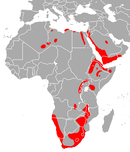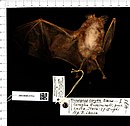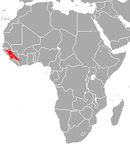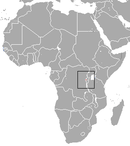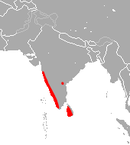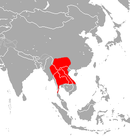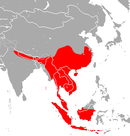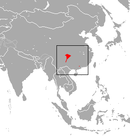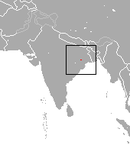List of horseshoe bats
Horseshoe bats are bats in the family Rhinolophidae, which is in the superfamily Rhinolophoidea. All extant horseshoe bats are in the genus Rhinolophus. There is one extinct genus of horseshoe bats, Palaeonycteris. As of 2019, there were 106 described species in Rhinolophus, making it the second-most speciose genus of bat after Myotis.[1]
Conventions[edit]
| Conservation status | |
|---|---|
| EX | Extinct (0 species) |
| EW | Extinct in the wild (0 species) |
| CR | Critically Endangered (1 species) |
| EN | Endangered (7 species) |
| VU | Vulnerable (6 species) |
| NT | Near threatened (8 species) |
| LC | Least concern (52 species) |
| Other categories | |
| DD | Data deficient (13 species) |
| NE | Not evaluated (17 species) |
Conservation statuses listed for each species follow the International Union for Conservation of Nature (IUCN) Red List of Threatened Species. The ![]() symbol indicates that the species's population trend is positive, the
symbol indicates that the species's population trend is positive, the ![]() symbol indicates that the species's population trend is negative, the
symbol indicates that the species's population trend is negative, the ![]() symbol indicates that the species's population is stable, and the
symbol indicates that the species's population is stable, and the ![]() symbol indicates that the species's population trend is unknown. Population trends are based on the Red List of Threatened Species. The super-scripted "IUCN" tag is a link to that species's Red List of Threatened Species page. If a species has taxonomic synonyms, a list of these is provided in the "Scientific name" column, underneath the binomial name and author. If a species has subspecies, a list of these is provided in the "Common name" column, underneath the common name.
symbol indicates that the species's population trend is unknown. Population trends are based on the Red List of Threatened Species. The super-scripted "IUCN" tag is a link to that species's Red List of Threatened Species page. If a species has taxonomic synonyms, a list of these is provided in the "Scientific name" column, underneath the binomial name and author. If a species has subspecies, a list of these is provided in the "Common name" column, underneath the common name.
Palaeonycteris[edit]
- † Palaeonycteris robustus: known only from fossils.[2]
Rhinolophus[edit]
Rhinolophus can be informally divided into two clades: the predominantly African clade and the predominantly Oriental clade.[3]
African clade[edit]
Subgenus Rhinolophus[edit]
| Subgenus Rhinolophus – 8 species groups,[a] 38 species | |||||||||||||||||||||||||||||||||||||||||||||||||||||||||||
Species group R. adami – 2 species
| |||||||||||||||||||||||||||||||||||||||||||||||||||||||||||
Species group R. capensis – 6 species
| |||||||||||||||||||||||||||||||||||||||||||||||||||||||||||
Species group R. euryale – 2 species
| |||||||||||||||||||||||||||||||||||||||||||||||||||||||||||
Species group R. ferrumquinum – 10 species
| |||||||||||||||||||||||||||||||||||||||||||||||||||||||||||
Species group R. fumigatus – 2 species
| |||||||||||||||||||||||||||||||||||||||||||||||||||||||||||
Species group R. hildebrandtii – 5 species
| |||||||||||||||||||||||||||||||||||||||||||||||||||||||||||
Species group R. landeri – 5 species
| |||||||||||||||||||||||||||||||||||||||||||||||||||||||||||
Species group R. maclaudi – 6 species
| |||||||||||||||||||||||||||||||||||||||||||||||||||||||||||
Oriental clade[edit]
Subgenus Aquias[edit]
| Subgenus Aquias – 1 species group, 9 species | ||||||||||||||||||||||||||||||||||||||||||||||||||||||
Species group R. trifoliatus – 9 species
| ||||||||||||||||||||||||||||||||||||||||||||||||||||||
Subgenus Phyllorhina[edit]
| Subgenus Phyllorhina – 1 species group, 1 species | ||||||||||||||
Species group R. hipposideros – 1 species
| ||||||||||||||
Subgenus Indorhinolophus[edit]
| Subgenus Indorhinolophus – 1 species group, 4 species | |||||||||||||||||||||||||||||
Species group R. rouxi – 4 species
| |||||||||||||||||||||||||||||
Subgenus Coelophyllus[edit]
| Subgenus Coelophyllus – 2 species groups, 17 species | ||||||||||||||||||||||||||||||||||||||||||||||||||||||||||||||||||||||||||
Species group R. pearsonii – 4 species
| ||||||||||||||||||||||||||||||||||||||||||||||||||||||||||||||||||||||||||
Species group R. euryotis – 13 species
| ||||||||||||||||||||||||||||||||||||||||||||||||||||||||||||||||||||||||||
Subgenus Rhinophyllotis[edit]
| Subgenus Rhinophyllotis – 3 species groups, 31 species | |||||||||||||||||||||||||||||||||||||||||||||||||||||||||||||||||||||
Species group R. megaphyllus – 12 species
| |||||||||||||||||||||||||||||||||||||||||||||||||||||||||||||||||||||
Species group R. philippinensis – 7 species
| |||||||||||||||||||||||||||||||||||||||||||||||||||||||||||||||||||||
Species group R. pusillus – 12 species
| |||||||||||||||||||||||||||||||||||||||||||||||||||||||||||||||||||||
Incertae sedis[edit]
Several taxa are of uncertain placement, or incertae sedis
incertae sedis – 4 species
| |||||||||||||||||||||||||||||
Notes[edit]
- ^ Csorba et al. described 7 species groups with R. hildebrandtii species included in R. fumigatus species group;[4] Taylor et al. by describing 4 new species separated R. hildebrandtii species group from R. fumigatus species group[5]
- ^ R. d. denti from Namibia and Zimbabwe to the Cape Province, R. d. knorri in Guinea, Ivory Coast, and Ghana[12]
- ^ R. s. simulator in eastern Africa from Ethiopia to Natal, R. s. alticolis in Guinea, Liberia, Nigeria, and Cameroon[13]
- ^ R. e. euryale in northwestern Africa, southern Europe to east to Turkmenistan and Iran; Mediterranean Islands; R. e. judaicus from Syria and south Iraq to Israel.[16]
- ^ a b Unidentifiable name.
- ^ R. m. mehelyiin Europe and Western Asia; R. m. tuneti in northern Africa[17]
- ^ R. c. clivosus in Yemen and Saudi Arabia; R. m. brachygnathus from Egypt and Israel to northeastern Libya and northern Sudan; R. c. schwartzi in southeastern Algeria and southwestern Libya; R. c. acrotis in Ethiopia, most of central and southern Sudan, Somalia; R. c. keniensis in southeastern Sudan, Uganda, Kenya, northern Tanzania; R. c. zuluensis in coastal South Africa; R. c. augur in southern Tanzania, Malawi, Zimbabwe, Botswana, and northern South Africa.[19]
- ^ R. f. ferrumequinum in Europe and northwestern Africa; R. f. creticum in Crete; R. f. irani in Iraq, Iran, and Turkmenistan; R. f. proximus from Afghanistan and Uzbekistan east to Kashmir; R. f. tragatus from northern India to eastern China; R. f. korai in Korea; R. f. nippon in Japan and eastern China.[23]
- ^ a b c d e nomen nudum
- ^ Renaming of R. unihastatus homorodalmasiensis (Daday, 1885)
- ^ A recent split from R. clivosis [28]
- ^ R. e. eloquens from Southern Sudan to eastern Zaire and northern Tanzania, Pemba and Zanzibar; R. e. perauritus in southern Somalia.[30]
- ^ R. f. fumigatus in Ethiopia; R. f. exsul from central Sudan to Tanzania; R. f. abae in northeastern Zaire; R. f. foxi from Central African Republic to Burkina Faso; R. f. diversus in Guinea, Sierra Leone, Gambia, and Senegal; R. f. aethiops from Zambia and Angole to the Cape Province, South Africa.[31]
- ^ R. b. blasii in northwestern Africa, southern Europe and southwestern Asia; R. b. meyeroehmi in Iran, Turkmenistan, Afghanistan, and Pakistan; R. b. andreinii in Ethiopia and Somalia; R. b. empusa in southeastern Africa from southern Zaire to Transvaal.[34]
- ^ R. l. landeri from Gambia to Cameroon and south to the mouth of the Congo river; R. l. angolensis in western Angolan and perhaps Namibia.[36]
- ^ R. b. beddomei in southern India; R. b. sobrinus in Sri Lanka.[41]
- ^ R. l. luctus in southern Sumatra, Java, Bali; R. l. spurcus in Hainan, China; R. l. foetidus in Borneo.[44]
- ^ a b c A recent split from R. luctus [28]
- ^ R. t. trifoliatus in Sumatra, Java, and Borneo; R. t. edax from northeastern India, Thailand through the Malay Peninsula; R. t. niasensis in Nias; R. t. solitarius in Bangka.[51]
- ^ R. f. francisi in Malaysia; R. f. thailandicus in Thailand.[52]
- ^ R. h. hipposideros in Continental Europe to the eastern end of Black Sea; R. h. escalerae in north Africa; R. h. minimus from southern Europe to the eastern end of Mediterranean, including several islands and south to Ethiopia and Sudan; R. h. majori in Corsica; R. h. minutus in Britain and Ireland; R. h. midas from Transcaucasia and Iraq to Kazakhstan and Kashmir.[53]
- ^ Preoccupied by Vespertilio molossus minor Kerr,1792
- ^ Renaming of R. bihastatus kisnyiresiensis Daday, 1885
- ^ Not of R. intermedius Söderland, 1920
- ^ R. r. rouxii in peninsular India and southern Myanmar; R. r. rubidus in Sri Lanka.[54]
- ^ Error for R. rubidus Kelaart, 1850
- ^ R. s. sinicus in the Himalayas, northern Vietnam, southeastern China, and Sichuan; R. s. septentrionalis in Yunnan.[56]
- ^ A recent split from R. yunanensis [28]
- ^ R. a. arcuatus in northern Philippines; R. a. beccarii in Sumatra; R. a. exiguus in southern Philippines; R. a. toxopei in Buru and Ambon; R. a. angustifolius in Wettar, Southwest Island, and Flores Sea.[62]
- ^ R. c. canuti in Java; R. c. timorensis in Timor.[64]
- ^ R. c. creaghi in Borneo; R. c. pilosus in Madura.[66]
- ^ R. e. euryotis from Seram Island to Tanimbar Islands; R. e. timidus from northern Moluccas through New Guinea to the Bismarcks; R. e. burius in Buru; R. e. praestans in Kai Islands; R. e. aruensis in Aru Islands. [67]
- ^ R. s. subrufus in northern and central Philippines; R. s. bunkeri in Mindanao.[72]
- ^ Preoccupied by R. rufus Eydoux & Gervais, 1836
- ^ R. a. affinis in Java; R. a. himalayanus in northern India and Nepal across northern Myanmar to southwestern China; R. a. macrurus in southeastern China through Vietnam and Thailand to southeastern Myanmar; R. a. hainanus in Hainan Island; R. a. tener in southwestern Myanmar; R. a. superans in Malay Peninsula and in Sumatra and Mentawai Islands; R. a. nesites on Anamba and North Natuna Islands; R. a. princeps in Lombok, Sumbawa, and Sumba.[74]
- ^ R. b. borneensis in Borneo; R. b. chaseni in Cambodia, Laos, Vietnam, and Malaysia; R. b. importunus in Java; R. b. spadix in South Natuna and Karimata.[76]
- ^ R. c. celebensis in Sulawesi; R. c. javanicus in Java and Bali; R. c. parvus in Timor.[77]
- ^ Replacement name for R. robinsoni siamensis McFarlane & Blood 1986[79]
- ^ R. m. megaphyllus in eastern Australia; R. m. simplex from Lombok to Komodo; R. m. fallax in southeastern New Guinea and D'Entrecasteaux Islands; R. m. monachus in Louisiades; R. m. vandeuseni in northeastern New Guinea and Bismarck Archipelago; R. m. truncatus in Bacan Islands; R. m. nanus on Seram and nearby islands; R. m. annectens on Wetar; R. m. robinsoni in Malay Peninsula; R. m. thaianus in northern Thailand.[80]
- ^ R. s. stheno in Java, Sumatra, Peninsular Malaysia, and Thailand south of the Isthmus of Kra; R. s. microglobosus in Thailand north of the Isthmus of Kra, Laos and Vietnam.[83]
- ^ R. m. macrotis in Nepal and India; R. m. episcopus in Sichuan, China; R. m. caldwelli in southeastern China and Vietnam; R. m. dohrni in Sumatra and Malaysia; R. m. hirsutus in the Philippines; R. m. topali in Pakistan.[85]
- ^ R. p. sanborni in Borneo; R. p. alleni in Mindoro; R. p. philippinensis on the remaining Philippines islands; R. p. maros in Sulawesi and New Guinea; R. p. achilles on Kai Islands; R. p. robertsi in northeastern Queensland. [89]
- ^ R. a. acuminatus in Java; R. a. sumatranus in Sumatra and Borneo; R. a. circe on Nias Island; R. a. calypso on Enggano Island; R. a. audax in Bali and Lombok.[93]
- ^ R. c. cognatus on south Andaman; R. c. famulus on north Andaman.[96]
- ^ R. c. cornutus on the main islands of Japan; R. c. pumilus on Okinawa; R. c. miyakonis on Miyako-jima; R. c. orii on Amami Ōshima and Tokunoshima.[99]
- ^ R. l. lepidus in central and northeastern India; R. l. monticola in Afghanistan and northwestern India; R. l. feae in northern Myanmar and northern Thailand; R. l. refulgens in Malay Peninsula; R. l. cuneatus in Sumatra.[103]
- ^ R. p. pusillus in Java and Borneo; R. p. blythi in northwestern India; R. p. gracilis in southern India; R. p. szechuanus in northeastern India, Myanmar, southwestern China and Thailand; R. p. calidus in eastern China; R. p. parcus in Hainan; R. p. minutillus in Malay Peninsula and Anambas; R. p. pagi on Mentawai Islands.[103]
- ^ Preoccupied by Vespertilio ferrumequinum minor Kerr, 1792
- ^ Preoccupeid by Vespertilio ferrumequinum minitus Montagu, 1808
- ^ Replacement name for R. minutus Miller, 1900
References[edit]
- ^ Demos et al. 2019.
- ^ Lydekker 1885.
- ^ Stoffberg et al. 2010.
- ^ Csorba et al. 2003, p. xvi.
- ^ a b c d e Taylor et al. 2012.
- ^ Aellen & Brosset 1968.
- ^ Csorba et al. 2003, p. 4.
- ^ Kock et al. 2000.
- ^ Csorba et al. 2003, p. 5.
- ^ a b c d Bogdanowicz 1992.
- ^ a b Csorba et al. 2003, p. 7.
- ^ a b Csorba et al. 2003, p. 9.
- ^ a b c Csorba et al. 2003, p. 10.
- ^ Csorba et al. 2003, p. 12.
- ^ a b c Taylor et al. 2018.
- ^ a b c Csorba et al. 2003, p. 14.
- ^ a b c Csorba et al. 2003, p. 17.
- ^ Csorba et al. 2003, p. 34.
- ^ a b c Csorba et al. 2003, p. 35.
- ^ Jacobs et al. 2013.
- ^ Csorba et al. 2003, p. 39.
- ^ Csorba et al. 2003, p. 41.
- ^ a b c Csorba et al. 2003, p. 42.
- ^ Koopman 1989, pp. 4–5.
- ^ a b Cotterill 2002.
- ^ Csorba et al. 2003, p. 132.
- ^ Csorba et al. 2003, p. 46.
- ^ a b c Taylor 2019, p. 365.
- ^ Benda & Vallo 2012.
- ^ a b Csorba et al. 2003, p. 47.
- ^ a b c Csorba et al. 2003, pp. 48–49.
- ^ Csorba et al. 2003, p. 51.
- ^ Csorba et al. 2003, p. 55.
- ^ a b Csorba et al. 2003, p. 57.
- ^ Csorba et al. 2003, p. 59.
- ^ a b Csorba et al. 2003, p. 61.
- ^ a b Fahr et al. 2002.
- ^ Csorba et al. 2003, p. 63.
- ^ Csorba et al. 2003, p. 65.
- ^ a b Kerbis Peterhans et al. 2013.
- ^ a b Csorba et al. 2003, p. 122.
- ^ Andersen 1905, p. 253.
- ^ Csorba et al. 2003, p. 123.
- ^ a b Csorba et al. 2003, p. 125.
- ^ "Explore the Database". www.mammaldiversity.org. Retrieved 2022-02-21.
- ^ a b Volleth et al. 2015.
- ^ Volleth et al. 2017.
- ^ "Explore the Database". www.mammaldiversity.org. Retrieved 2022-02-21.
- ^ Csorba et al. 2003, p. 127.
- ^ Soisook et al. 2010.
- ^ a b Csorba et al. 2003, p. 128.
- ^ a b c d Soisook et al. 2015.
- ^ a b Csorba et al. 2003, p. 53.
- ^ a b Csorba et al. 2003, p. 115.
- ^ Chattopadhyay et al. 2012, p. 115.
- ^ a b Csorba et al. 2003, p. 118.
- ^ Csorba et al. 2003, p. 120.
- ^ Yoshiyuki & Lim 2005.
- ^ Csorba et al. 2003, p. 82.
- ^ Wu et al. 2009.
- ^ Csorba et al. 2003, p. 84.
- ^ a b Csorba et al. 2003, p. 18.
- ^ a b c d Patrick et al. 2013.
- ^ a b Csorba et al. 2003, p. 21.
- ^ Csorba et al. 2003, p. 23.
- ^ a b Csorba et al. 2003, p. 24.
- ^ a b Csorba et al. 2003, p. 26.
- ^ Csorba et al. 2003, p. 28.
- ^ Hill & Schlitter 1982.
- ^ Csorba et al. 2003, p. 29.
- ^ Csorba et al. 2003, p. 31.
- ^ a b Csorba et al. 2003, p. 32.
- ^ Bergmans & Rozendaal 1982.
- ^ a b Csorba et al. 2003, p. 66.
- ^ Srinivasulu et al. 2019.
- ^ a b Csorba et al. 2003, p. 69.
- ^ a b Csorba et al. 2003, p. 71.
- ^ Csorba et al. 2003, p. 73.
- ^ Corbet & Hill 1992, p. 101.
- ^ a b Csorba et al. 2003, pp. 74–75.
- ^ Gray 1834.
- ^ Csorba et al. 2003, pp. 77.
- ^ a b Csorba et al. 2003, p. 78.
- ^ Csorba et al. 2003, p. 80.
- ^ a b Csorba et al. 2003, p. 85.
- ^ Csorba et al. 2003, p. 88.
- ^ Csorba et al. 2003, p. 90.
- ^ Csorba et al. 2003, p. 91.
- ^ Csorba et al. 2003, pp. 92–93.
- ^ Csorba et al. 2003, p. 92.
- ^ Csorba et al. 2003, p. 95.
- ^ Wu & Thong 2011.
- ^ Csorba et al. 2003, pp. 96–97.
- ^ Peters 1871.
- ^ Csorba et al. 2003, p. 96.
- ^ a b Csorba et al. 2003, p. 98.
- ^ Csorba 1997.
- ^ Csorba et al. 2003, p. 100.
- ^ a b Csorba et al. 2003, p. 101.
- ^ Hill & Yoshiyuki 1980.
- ^ Csorba et al. 2003, p. 103.
- ^ a b Wu et al. 2012.
- ^ a b c Csorba et al. 2003, p. 104.
- ^ Csorba et al. 2003, p. 107.
- ^ Csorba et al. 2003, p. 108.
- ^ Csorba et al. 2003, p. 110.
- ^ Csorba et al. 2003, p. 113.
- ^ Csorba et al. 2003, p. 114.
- ^ Csorba et al. 2003, p. 130.
- ^ Wu et al. 2008.
- ^ Zhou et al. 2009.
Bibliography[edit]
- Aellen, V.; Brosset, A. (1968). "Chiroptères du sud du Congo (Brazzaville)". Revue Suisse de Zoologie. 75 (14): 435–458. doi:10.5962/bhl.part.97040.
- Andersen, K. (1905). "XXVIII.—On the Bats of the Rhinolophus philippinensis Group, with Descriptions of Five new Species". Journal of Natural History. 16 (92): 243–257. doi:10.1080/03745480509443674.
- Benda, P.; Vallo, P. (2012). "New look on the geographical variation in Rhinolophus clivosus with description of a new horseshoe bat species from Cyrenaica, Libya" (PDF). Vespertilio. 16: 69–96. S2CID 85814849. Archived from the original (PDF) on 2020-02-18.
- Bergmans, W.; Rozendaal, F. G. (1982). "Notes on Rhinolophus Lacépède, 1799 from Sulawesi, Indonesia". Bijdragen tot de Dierkunde. 52 (2): 169–174. doi:10.1163/26660644-05202007.
- Bogdanowicz, Wiesław (1992). "Phenetic relationships among bats of the family Rhinolophidae". Acta Theriologica. 37: 213–240. doi:10.4098/AT.arch.92-22.
- Chattopadhyay, Balaji; Garg, Kritika; Kumar, Vinoth; D., Paramanantha; Ramakrishnan, Uma; Kandula, Sripathi (2012-12-01). "Sibling species in South Indian populations of the rufous horse-shoe bat Rhinolophus rouxii". Conservation Genetics. 13 (6): 1435–1445. doi:10.1007/s10592-012-0361-y. S2CID 15943483.
- Corbet, G.B.; Hill, J.E. (1992). The Mammals of the Indomalayan Region. Natural History Museum Publications, Oxford University Press.
- Cotterill, Fenton Peter David (2002). "A new species of horseshoe bat (Microchiroptera: Rhinolophidae) from south-central Africa: With comments on its affinities and evolution, and the characterization of rhinolophid species". Journal of Zoology. 256 (2). London: 165–179. doi:10.1017/S0952836902000201.
- Csorba, G. (1997). "Description of a new species of Rhinolophus (Chiroptera: Rhinolophidae) from Malaysia". Journal of Mammalogy. 78 (2): 342–347. doi:10.2307/1382887. JSTOR 1382887.
- Csorba, G.; Ujhelyi, P.; Thomas, P. (2003). Horseshoe Bats of the World: (Chiroptera: Rhinolophidae). Alana Books. ISBN 9780953604913.
- Demos, Terrence C.; Webala, Paul W.; Goodman, Steven M.; Kerbis Peterhans, Julian C.; Bartonjo, Michael; Patterson, Bruce D. (2019). "Molecular phylogenetics of the African horseshoe bats (Chiroptera: Rhinolophidae): Expanded geographic and taxonomic sampling of the Afrotropics". BMC Evolutionary Biology. 19 (1): 166. doi:10.1186/s12862-019-1485-1. PMC 6704657. PMID 31434566.
- Fahr, Jakob; Vierhaus, Henning; Hutterer, Rainer; Kock, Dieter (December 2002). "A revision of the Rhinolophus maclaudi species group with the description of a new species from West Africa (Chiroptera: Rhinolophidae)". Myotis. 40. Bonn: 95–126.
- Gray, J.E. (1834). "Characters of a New Species of Bat from New Holland, collected by G. Bennet". Proceedings of the Zoological Society of London. 1834. Academic Press, [etc.]: 52–53.
- Hill, JE; Yoshiyuki, M (1980). "A new species of Rhinolophus (Chiroptera, Rhinolophidae) from Iriomote Island, Ryukyu Islands, with notes on the Asiatic members of the Rhinolophus pusillus group". Bull Natl Sci Mus a Zool. 6: 179–189.
- Hill, J. E.; Schlitter, D. A. (1982). "A Record of Rhinolophus Arcuatus (Chiroptera, Rhinolophidae) from New Guinea, with the Description of a New Subspecies". Carnegie Museum of Natural History. 51: 459–463.
- Jacobs, David S; Babiker, Hassan; Bastian, Anna; Kearney, Teresa; Van Eeden, Rowen; Bishop, Jacqueline M (2013). "Phenotypic Convergence in Genetically Distinct Lineages of a Rhinolophus Species Complex (Mammalia, Chiroptera)". PLOS ONE. 8 (12): e82614. Bibcode:2013PLoSO...882614J. doi:10.1371/journal.pone.0082614. PMC 3849494. PMID 24312666.
- Kerbis Peterhans, Julian C.; Fahr, Jakob; Huhndorf, Michael H.; Kaleme, Prince; Plumptre, Andrew J.; Marks, Ben D.; Kizungu, Robert (December 2013). "Bats (Chiroptera) from the Albertine Rift, eastern Democratic Republic of Congo, with the description of two new species of the Rhinolophus maclaudi group". Bonn Zoological Bulletin. 62 (2): 186–202.
- Kock, Dieter; Csorba, Gábor; Howell, Kim M. (2000). "Rhinolophus maendeleo n. sp. from Tanzania, a horseshoe bat noteworthy for its systematics and biogeography (Mammalia,Chiroptera,Rhinolophidae)". Senckenbergiana Biologica. 80 (1/2): 233–239.
- Koopman, Karl F. (June 28, 1989). "Systematic Notes on Liberian Bats" (PDF). American Museum Novitates (2946): 11.
- Koopman, Karl F. (1994). "Chiroptera: Systematics". In Walter de Gruyter (ed.). Handbuch der Zoologie. Berlin. ISBN 9783110140811.
{{cite book}}: CS1 maint: location missing publisher (link) - Lydekker, Richard (1885). Catalogue of the Fossil Mammalia in the British Museum, (Natural History): The orders Primates, Chiroptera, Insectivora, Carnivora, and Rodentia. Order of the Trustees. p. 13.
- Patrick, L. E.; McCulloch, E. S.; Ruedas, L. A. (2013). "Systematics and biogeography of the arcuate horseshoe bat species complex (Chiroptera, Rhinolophidae)". Zoologica Scripta. 42 (6): 553–590. doi:10.1111/zsc.12026. S2CID 86540277.
- Peters, W. (1871). "Über die Gattungen und Arten der Hufeisennasen, Rhinolophi". Monatsberichte der Königlichen Preussische Akademie des Wissenschaften zu Berlin. 1871: 308–309.
- Soisook, P.; Niyomwan, P.; Srikrachang, M.; Srithongchuay, T.; Bates, P. J. (2010). "Discovery of Rhinolophus beddomei (Chiroptera: Rhinolophidae) from Thailand with a brief comparison to other related taxa". Tropical Natural History. 10 (1): 67–79.
- Soisook, Pipat; Struebig, Matthew; Noerfahmy, Sephy; Bernard, Henry; Maryanto, Ibnu; Chen, Shiang-Fan; Rossiter, Stephen; Kuo, Hao-Chih; Deshpande, Kadambari; Bates, Paul; Sykes, Dan; Portela Miguez, Roberto (2015). "Description of a New Species of the Rhinolophus trifoliatus-Group (Chiroptera: Rhinolophidae) from Southeast Asia". Acta Chiropterologica. 17 (1): 21. doi:10.3161/15081109ACC2015.17.1.002. S2CID 83470278.
- Srinivasulu, Chelmala; Srinivasulu, Aditya; Srinivasulu, Bhargavi; Jones, Gareth (2019-10-10). "Integrated approaches to identifying cryptic bat species in areas of high endemism: The case of Rhinolophus andamanensis in the Andaman Islands". PLOS ONE. 14 (10): e0213562. Bibcode:2019PLoSO..1413562S. doi:10.1371/journal.pone.0213562. ISSN 1932-6203. PMC 6786537. PMID 31600196.
- Stoffberg, Samantha; Jacobs, David S.; MacKie, Iain J.; Matthee, Conrad A. (2010). "Molecular phylogenetics and historical biogeography of Rhinolophus bats". Molecular Phylogenetics and Evolution. 54 (1): 1–9. doi:10.1016/j.ympev.2009.09.021. PMID 19766726.
- Taylor, Peter J.; Stoffberg, Samantha; Monadjem, Ara; Schoeman, Martinus Corrie; Bayliss, Julian; Cotterill, Fenton P. D. (2012). "Four New Bat Species (Rhinolophus hildebrandtii Complex) Reflect Plio-Pleistocene Divergence of Dwarfs and Giants across an Afromontane Archipelago". PLOS ONE. 7 (9): e41744. Bibcode:2012PLoSO...741744T. doi:10.1371/journal.pone.0041744. PMC 3440430. PMID 22984399.
- Taylor, PJ; Macdonald, A; Goodman, SM; Kearney, T; Cotterill, FP; Stoffberg, S; Monadjem, A; Schoeman, MC; Guyton, J; Naskrecki, P; Richards, LR (2018). "Integrative taxonomy resolves three new cryptic species of small southern African horseshoe bats (Rhinolophus)". Zoological Journal of the Linnean Society. 184 (4): 1249–1276. doi:10.1093/zoolinnean/zly024. hdl:10019.1/111734.
- Taylor, Marianne (2019). Tuttle, Merlin D. (ed.). Bats: an illustrated guide to all species. Ivy Press. ISBN 978-1-78240-557-3.
- Volleth, Marianne; Loidl, Josef; Mayer, Frieder; Yong, Hoi Sen; Müller, Stefan; Heller, Klaus-Gerhard (2015). "Surprising Genetic Diversity in Rhinolophus luctus (Chiroptera: Rhinolophidae) from Peninsular Malaysia: Description of a New Species Based on Genetic and Morphological Characters". Acta Chiropterologica. 17: 1–20. doi:10.3161/15081109ACC2015.17.1.001. S2CID 86009452.
- Volleth, Marianne; Truong Son, Nguyen; Wu, Yi; Li, Yuchun; Yu, Wenhua; Lin, Liang-Kong; Arai, Satoru; Trifonov, Vladimir; Liehr, Thomas; Harada, Masashi (1 June 2017). "Comparative Chromosomal Studies in Rhinolophus formosae and R. luctus from China and Vietnam: Elevation of R. l. lanosus to Species Rank". Acta Chiropterologica. 19 (1): 41–50. doi:10.3161/15081109ACC2017.19.1.003. S2CID 90913285.
- Wu, Yi; Motokawa, Masaharu; Harada, Masashi (2008). "A New Species of Horseshoe Bat of the Genus Rhinolophus from China (Chiroptera: Rhinolophidae)". Zoological Science. 25 (4): 438–443. doi:10.2108/zsj.25.438. hdl:2433/85312. PMID 18459826. S2CID 207286319.
- Wu, Yi; Harada, Masashi; Motokawa, Masaharu (1 December 2009). "Taxonomy of Rhinolophus yunanensis Dobson, 1872 (Chiroptera: Rhinolophidae) with a Description of a New Species from Thailand". Acta Chiropterologica. 11 (2): 237–246. doi:10.3161/150811009X485486. S2CID 84778242.
- Wu, Yi; Thong, Vu Dinh (2011). "A new species of Rhinolophus (Chiroptera: Rhinolophidae) from China". Zoological Science. 28 (3): 235–241. doi:10.2108/zsj.28.235. PMID 21385065. S2CID 27079599.
- Wu, Yi; Motokawa, Masaharu; Harada, Masashi; Thong, Vu Dinh; Lin, Liang-Kong; Li, Yu-Chun (2012). "Morphometric Variation in the pusillus Group of the Genus Rhinolophus (Mammalia: Chiroptera: Rhinolophidae) in East Asia". Zoological Science. 29 (6): 396–402. doi:10.2108/zsj.29.396. PMID 22639811. S2CID 29825075.
- Yoshiyuki, Mizuko; Lim, Boo Liat (2005). "A New Horseshoe Bat, Rhinolophus chiewkweeae (Chiroptera, Rhinolophidae), from Malaysia". Bulletin of the National Science Museum Tokyo, Series A. 31 (1): 29–36.
- Zhou, Z. M.; Guillén-Servent, A.; Lim, B. K.; Eger, J. L.; Wang, Y. X.; Jiang, X. L. (2009). "A new species from southwestern China in the Afro-Palearctic lineage of the horseshoe bats (Rhinolophus)". Journal of Mammalogy. 90 (1): 57–73. doi:10.1644/08-MAMM-A-048.1.


 French
French Deutsch
Deutsch












